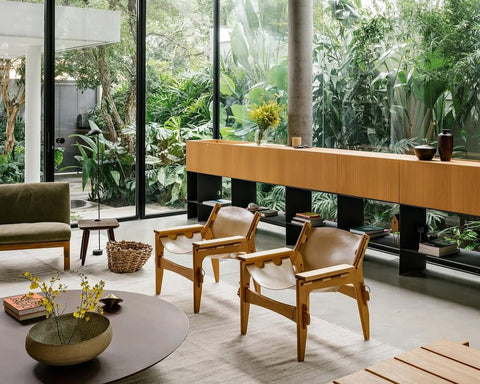Wood is a material that not only sustains nature but also becomes a form of expression of the culture and technology of our time. – Oscar Niemeyer
A material that blends tradition and innovation, wood carries with it the beauty of nature, but also the responsibility to preserve it. In this context, the FSC certification emerges as one of the most reliable guarantees for those who want to choose eco-sustainable materials without compromising the quality of their furniture. But what is a FSC certificate exactly and how does it impact design choices?
FSC Certification meaning
The FSC certification, which stands for Forest Stewardship Council, is an international system that ensures wood and derived products come from forests that are responsibly and sustainably managed. The FSC certification promotes the protection of forest ecosystems, the respect of local community rights, and the fight against illegal deforestation through a rigorous auditing and control process.
FSC Timber certification
The FSC certificate guarantees that the wood supply chain, from the forest to the final product, meets high environmental, social, and economic standards. It is an independent third-party certification, solely focused on protecting the environment. To be certified, the wood used for furniture and decor must come from forests managed according to FSC standards. These standards are very strict and cover aspects like biodiversity, water resource management, the welfare of animals and plants, and the rights of local communities.

FSC Paper certification
Similarly, the FSC certification for paper follows the same principles: paper and cardboard used for packaging, brochures, catalogs, and other derived products must come from sustainably managed forests. Many companies in the design sector, including those selling furniture and accessories, choose to use FSC certified paper for their informational materials, packaging, and visual communication, promoting a culture of sustainability that is reflected in their way of working.

Forest Stewardship and Chain of Custody: two types of FSC certificate
The FSC certification is divided into two main categories:
-
Forest Stewardship certification concerns the management practices of plantations and forests, ensuring that they are managed responsibly, protecting biodiversity, natural resources, and the rights of local communities. Aimed at forest owners and managers, it ensures, through 10 principles and 70 criteria (P&C) established by FSC, that forests are sustainably harvested without compromising their ability to regenerate.
-
Chain of Custody certification, on the other hand, concerns the traceability of wood and non-wood materials throughout the entire production chain, from the forest to the final product. The FSC certificate check ensures that wood from certified forests is handled and processed transparently and responsibly, without mixing with non-certified materials. This certification allows businesses to label their products as FSC certified, informing consumers of their commitment to environmental sustainability.
Both certifications can be individual — in the case of Forest Stewardship, when certifying a single plantation or forest, or for Chain of Custody, when requested by individual organizations — or group certifications, referring to multiple forest units under the same FSC certificate in Forest Stewardship, or multiple organizations with multisite certifications in Chain of Custody.
How to obtain FSC Certification
Obtaining the FSC certificate is not a simple process: it requires adherence to strict standards, including the traceability of the product throughout the supply chain, from wood or paper collection to transformation and distribution. Companies wishing to get certified must undergo an external audit conducted by FSC accredited certification bodies.
The process includes the evaluation of environmental impact, management of social rights and local communities, protection of animal and plant species, and verification of transparency in fund management. Once obtained, the FSC certificate must be renewed periodically through scheduled audits.

Benefits of FSC certification for the environment and interior design
The FSC certification is not just about respecting the environment, but also about adding value to interior design. When you choose an FSC certified product, you're not just selecting a beautiful and functional piece, but an item that tells a story of responsibility — a commitment that reflects in both the aesthetic value and the quality of the design itself. In summary, we can outline the main benefits of FSC certification as follows:
-
Sustainability. The primary reason behind FSC certification is environmental protection. Supporting this certification means contributing to the preservation of forests and promoting reforestation efforts.
-
Superior Quality. FSC certified forests are managed in such a way as to ensure superior wood quality, resulting in durable and long-lasting furniture.
-
Aesthetic Value. FSC certified wood often features unique grains and textures, which not only tells a story of responsibility but also adds a touch of sophistication and natural beauty to furniture.
-
Transparency. The FSC certification ensures that every step of the production chain is traceable, guaranteeing the highest level of ethics and transparency in material sourcing.
The beauty and refinement of Brazilian design, promoted by Tropicalistic, perfectly aligns with the sustainability brought by the FSC certification. Purchasing FSC certified wood chairs, tables, furniture and accessories is not just an aesthetic choice: it’s a commitment to a greener and more responsible world, without sacrificing class and quality.

Conclusion
In a world where sustainability is becoming increasingly central, the FSC certification is a seal that guarantees the materials you choose not only respect the environment but also signify quality and elegance. Whether it's wood or paper, choosing FSC certified products is a step toward more conscious, beautiful, and, most importantly, environmentally respectful interior design.




(0)